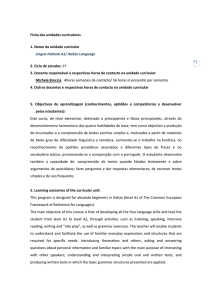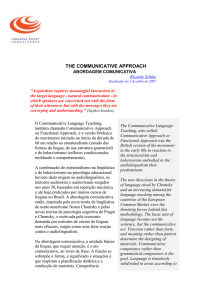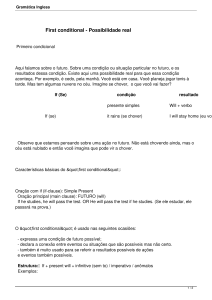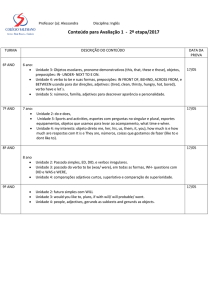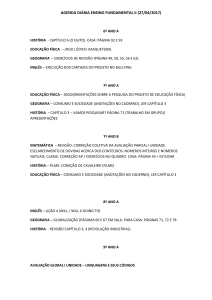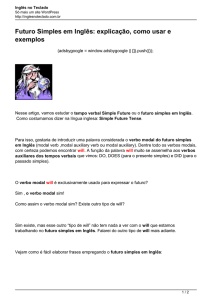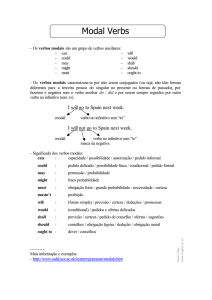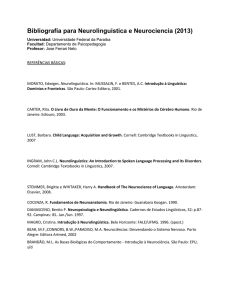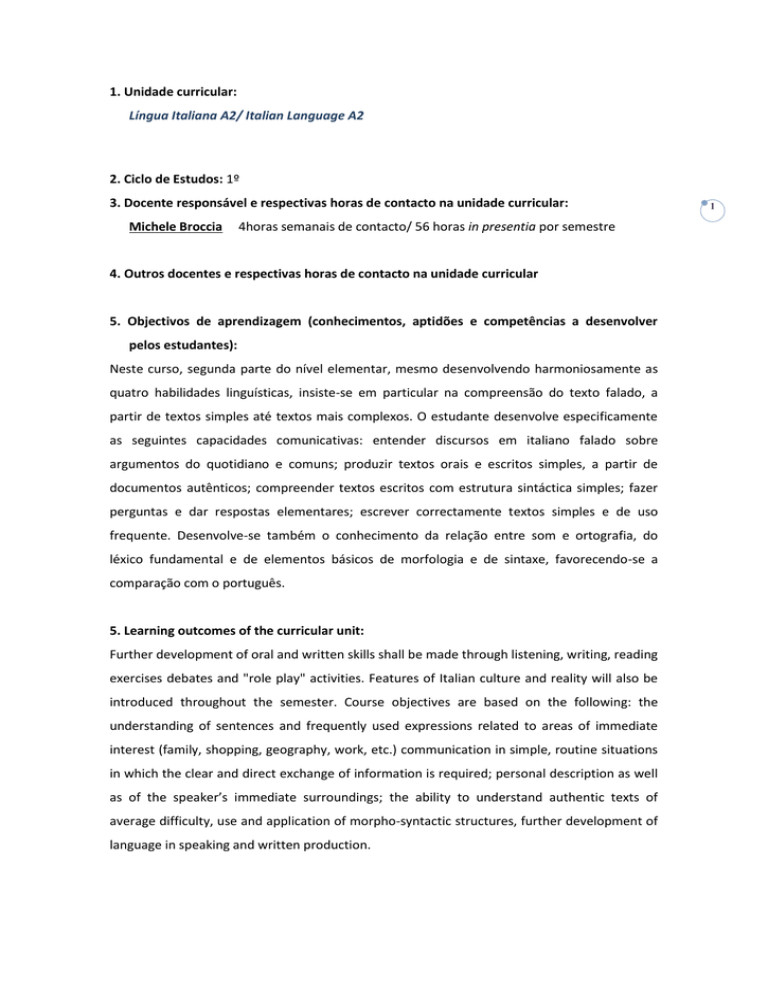
1. Unidade curricular:
Língua Italiana A2/ Italian Language A2
2. Ciclo de Estudos: 1º
3. Docente responsável e respectivas horas de contacto na unidade curricular:
Michele Broccia
4horas semanais de contacto/ 56 horas in presentia por semestre
4. Outros docentes e respectivas horas de contacto na unidade curricular
5. Objectivos de aprendizagem (conhecimentos, aptidões e competências a desenvolver
pelos estudantes):
Neste curso, segunda parte do nível elementar, mesmo desenvolvendo harmoniosamente as
quatro habilidades linguísticas, insiste-se em particular na compreensão do texto falado, a
partir de textos simples até textos mais complexos. O estudante desenvolve especificamente
as seguintes capacidades comunicativas: entender discursos em italiano falado sobre
argumentos do quotidiano e comuns; produzir textos orais e escritos simples, a partir de
documentos autênticos; compreender textos escritos com estrutura sintáctica simples; fazer
perguntas e dar respostas elementares; escrever correctamente textos simples e de uso
frequente. Desenvolve-se também o conhecimento da relação entre som e ortografia, do
léxico fundamental e de elementos básicos de morfologia e de sintaxe, favorecendo-se a
comparação com o português.
5. Learning outcomes of the curricular unit:
Further development of oral and written skills shall be made through listening, writing, reading
exercises debates and "role play" activities. Features of Italian culture and reality will also be
introduced throughout the semester. Course objectives are based on the following: the
understanding of sentences and frequently used expressions related to areas of immediate
interest (family, shopping, geography, work, etc.) communication in simple, routine situations
in which the clear and direct exchange of information is required; personal description as well
as of the speaker’s immediate surroundings; the ability to understand authentic texts of
average difficulty, use and application of morpho-syntactic structures, further development of
language in speaking and written production.
1
6. Conteúdos programáticos:
Funções comunicativos e lexicais: Falar de problemas sentimentais , expressar posse, ordenar
ao restaurante, expressar preferência; contar o enredo dum filme; falar de lembranças;
descrever hábitos do passado; contar e descrever ao passado; expressar acordo ou desacordo;
falar de cinema; fazer compras ao supermercado; motivar a escolha dum produto; expressar
felicidade ou infelicidade; oferecer, aceitar, recusar ajuda; contar um encontro; pedir e
expressar uma opinião; falar de programas e motivar as preferências; pedir o favor, expressar
um desejo; dar conselhos; dar ordens; pedir e dar direções; falar dum concerto; expressar um
desejo realizável; expressar uma opinião pessoal; fazer hipóteses; referir de opiniões de outros
ou uma noticia; expressar um desejo não realizado ou não realizável; expressar o futuro no
passado
Léxico: A família, Nomes dos parentes, pratos de comida italiana, as refeições, verbos para
cozinhar e nomes dos utensílios da cozinha; quantidades; tipos de contendores e de lojas;
palavras úteis para fazer compras: tamanhos, números, colores, estilos, preços, tipos de
pagamentos, tipos de roupa, verbos impessoais; música
Gramatica: pronomes directos e indirectos; NE e CI; particípio passado e pretérito perfeito
composto de verbos regulares e irregulares; imperfeito do indicativo; imperativo directo;
futuro simples de verbos regulares e irregulares; período hipotético da realidade. Léxico:
ambiente lexical do quotidiano. Fonética e fonologia: relação entre a fonética e a ortografia;
intonações. Fonemas do italiano.
6 Syllabus:
The program is based on a communicative approach to language and therefore students will
learn how to use language expressions and notions on a communicative context and grammar
will be taught on a deductive basis, reinforced with activities or exercises.
The syllabus for the A2 level will contain the following language functions: talking about
sentimental problems, Express possession; Ordering at the restaurant, Express preferences;
tell the plot of a film; Talk about memories, describe past habits; tell and describe past event;
Express agreement and disagreement; Talking about cinema; Doing shopping at the
supermarket; Express happiness; Offering, accepting, refusing help; Ask and express an
opinion; Discuss a TV program; Motivate and/or criticize one’s favorite programs; Apologize,
ask for a favor, Express a desire; Advise, Give orders; Ask and give directions; Talk about a
concert; Express a realizable wish or a unrealized wish or unrealizable; ask for something; Draw
a hypothesis, Refer somebody’s wish, or news, express the future in the past.
And lexicon about the following fields: Family; Relatives, Italian dishes, Meals, verbs and tools
2
used in the kitchen; quantities; types of shops and containers; Useful expressions to do
shopping: size, number, color, style, price, types of payment; types of clothing, impersonal
verbs; music
In order to pursue the objectives set in A1 level, the program will focus on the study of the
basic language structure with particular emphasis on Italian morphology, syntax, semantics
and lexicology.
7. Demonstração da coerência dos conteúdos programáticos com os objectivos de
aprendizagem da unidade curricular.
Neste nível, elementar avançado, insiste-se em particular na compreensão do texto falado, a
partir de textos simples e avançando até textos mais complexos. Visa-se igualmente a
compreensão de textos escritos com estrutura sintáctica simples, sobre temas conhecidos,
assim como a produção de textos orais e escritos simples, motivada a partir de documentos
autênticos. Desenvolve-se o conhecimento do léxico fundamental e de elementos básicos de
morfologia e de sintaxe. O estudante, no final do curso terá aprendido e compreendido,
através o uso de uma metodologia de tipo comunicativo, os conteúdos programáticos da
cadeira. Estes correspondem ao que é pedido no Quadro Europeu do ensino da língua.
7. Demonstration of the syllabus coherence with the curricular unit's objectives.
This is the second part for beginner users of Italian. This course helps students to:
Understand the main points of clear standard input on familiar matters regularly encountered
in work, school, leisure, etc. deal with most situations likely to arise whilst travelling in an area
where the language is spoken; Produce simple connected text on topics which are familiar or
of personal interest; Describe experiences and events, dreams, hopes and ambitions and
briefly give reasons and explanations for opinions and plans. The syllabus is coherent with the
curricular objectives because they are expressed in terms of language functions and thus they
say what the student will be able to do, in linguistic terms, at the end of the course.
8. Metodologias de ensino (avaliação incluída):
A metodologia utilizada vai ser de tipo eclético, quer dizer que dentro de uma abordagem
comunicativa o professor também usará os métodos tradicionais de ensino, de maneira que a
aprendizagem possa ser tão eficaz quanto possível para o maior número de alunos. Os alunos
poderão fazer atividades de role play, de grupo, houver canções, e fazer exercícios de
gramática, preencher módulos, etc.
A avaliação é contínua e visa verificar a aprendizagem dos conteúdos programáticos: os
3
elementos comunicativos e lexicais e a gramática.
Como formulado do Regulamento de Avaliação definem-se o numero, a categoria e o valor
percentual relativo das provas e dos outros elementos de avaliação:
-Participação, trabalhos de casa, disciplina, assiduidade e eventual apresentação de trabalhos
(10% - 2 pontos);
-Competência comunicativa oral (falar) (20% - 4 pontos), avaliada ao longo das aulas;
-1 Teste (Primeiro teste) de competência gramatical, metalinguística e lexical (30% - 6 pontos),
baseado sobre a primeira parte do programa;
-1 Teste (Segundo teste) de competência de leitura e gramatical, uma breve redação escrita,
prova oral (escutar) (40% - 8 pontos), baseado sobre a segunda parte do programa).
8. Teaching methodologies (including evaluation):
The teacher will use an eclectic methodology within a communicative general approach. It
means that the main objective will be that of leading students to acquire a communicative
competence at an elementary level. Eclecticism means that the teacher will avail oneself of
different methods, activities or exercises, in order the teaching to be more effective as possible
for the higher number of students. Therefore students will carry out role plays, pair or group
activities, listen to songs, do grammar exercises, fill in forms, etc.
Evaluation is continuous and aimed at verifying the program contents: lexicon and
communicative features and grammar notions.
In accordance with the Rules of Evaluation the number, genre and percentage value attributed
to the different evaluation methods are the following:
- Participation, homework assignments, discipline, attendance and the possible presentation of
written assignment (10% - 2 points);
- Oral communicative competence (speaking), (20% - 4 points), evaluated during classes;
- 1 test (first test) based on grammar, lexicon and communicative competence acquired during
the first part of the course (30% - 6 points);
- 1 Reading, writing, listening tests. The short composition will be on topics studied during
classroom sessions. The test will be based mainly on the program carried out during the
second part of the course (40 %) – 8 points;
9. Demonstração da coerência das metodologias de ensino com os objectivos de
aprendizagem da unidade curricular.
Tendo em conta os descritores do Quadro Comum Europeu de Referencia para as Línguas,
este nível, baseia-se em princípios metodológicos graças aos quais o estudante poderá ser
4
capaz de comunicar oralmente e por escrito com facilidade e segurança em situações reais.
Respeitando portanto o modelo europeu de competência linguístico-comunicativa, a
aprendizagem basear-se-á na articulação das 3 sub- competências: competência linguística;
competência sociolinguística e competência pragmática. Consequentemente uma particular
importância será dada ao desenvolvimento das capacidades comunicativas estimuladas
através de actividades como jogos de role-play; estudo de material autêntico; canções; vídeos.
Ao mesmo tempo será feita uma constante reflexão gramatical com momentos de reforço e
sistematização dos conceitos apreendidos. Grande relevo será dado também à discussão sobre
a vida e a cultura italiana. Filmes, vídeos sobre a actualidade; leituras de textos de jornalistas e
escritores contemporâneos; noções sobre a língua, as suas origens, a história, a literatura, o
cinema, serão parte do curso. Os estudantes serão capazes de chegar aos objectivos prefixados
participando em trabalhos de grupo, desenvolvendo trabalhos individuais, fazendo pesquisas
sobre aspectos socioculturais, assistindo a sessões de cinema, participando a visitas de estudos
e eventos culturais promovidos pela Embaixada de Itália.
9. Demonstration of the coherence between the teaching methodologies and the learning
outcomes.
The main objective of teaching and learning methodologies is to contribute towards
participatory, dialectical and autonomous study.
The proposed methodology for assessing learning aims at stimulating ongoing work, ensuring
regular and constant feedback on the acquired skills both at a written and oral level.
Given the overall competence descriptors of the Common European Framework of Reference
for Languages, this course unit aims to achieve the level A2.
The focus is therefore given to: the understanding of simple oral and written texts related to
the needs of everyday life; the interaction and simple oral and written production mobilizing
elementary vocabulary and common structures.
In short, the methodology must be practice-oriented, with a communicative focus because it
considers language as an instrument to communicate, be and do.
5
10. Bibliografia de consulta/existência obrigatória.
T. Marin, Nuovo Progetto Italiano 1 – Libro dello studente, Edizioni Edilingua, Roma,
2009. [Unità 6-11]
T. Marin, Nuovo Progetto Italiano 1 - Quaderno degli esercizi, Edizioni Edilingua, Roma,
2013.
Nocchi Susanna, Nuova Grammatica Pratica della Lingua Italiana, Alma Edizioni,
Firenze, 2012.
Lista sites de língua e cultura, exercícios on-line.
Dicionário: Lo Zingarelli Minore, Ed. Zanichelli (dizionario monolingue)
Outro material utilizado: fotocópias de língua e cultura; dvds (filmes e documentários); power
points; cd-audio.
6

